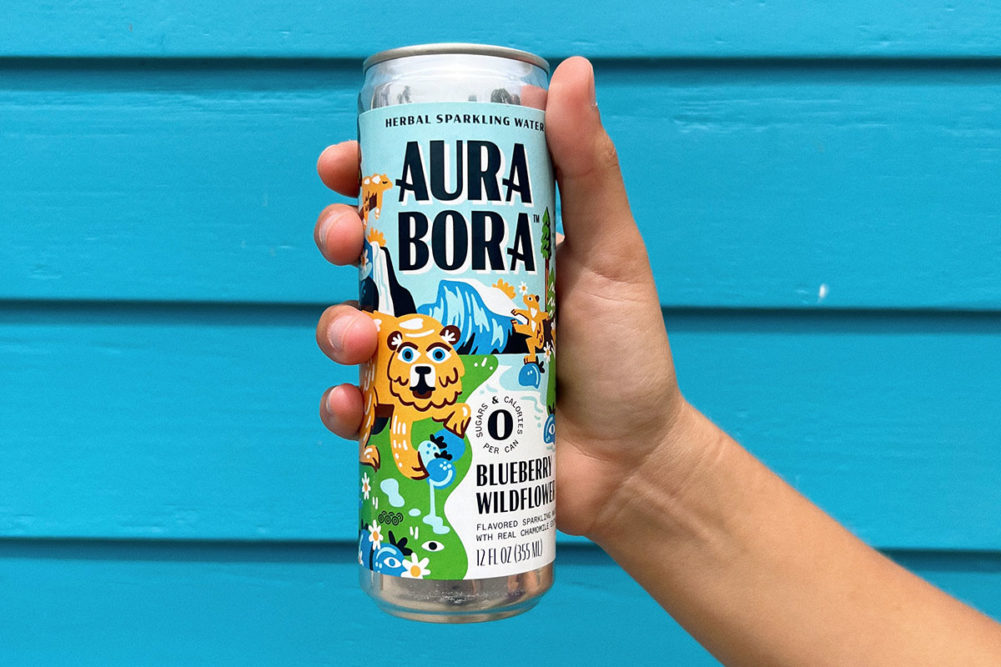In our monthly “SKU View” series, Food Entrepreneur is tapping the expertise of mentors and startup founders at SKU, a consumer products accelerator based in Austin, Texas, to deliver timely insights on issues that affect early-stage food and beverage brands.
AUSTIN, TEXAS — Limited-time offerings, brand collaborations and compelling packaging design are all effective ways to build brand awareness, said Paul Voge, co-founder of Aura Bora, a San Francisco-based beverage startup.
A few months prior to the pandemic, he and his wife, Madeleine, launched Aura Bora, a line of sparkling water flavored with herbs, fruits and flowers and featuring whimsical can branding. The pair navigated numerous challenges in the early days of the business as sampling opportunities were suspended.
An appearance on the television show “Shark Tank” last year helped the brand gain visibility. Today, the products are available in 4,000 stores nationwide.
Mr. Voge, who participated in the SKU accelerator program two years ago, shared marketing advice for bootstrapped brands.
Food Entrepreneur: Before you had a marketing budget, what type of things did you do to let the world know about Aura Bora?
Paul Voge: The best marketing is a strong salesperson. The next best marketing is your packaging. Design a compelling offering, and you’ve done half the work. The rest is execution.
How can bootstrapped brands get the attention of their target consumers?
Mr. Voge: The best way to build a CPG brand is in store. Sell into one small chain in your target market, and just worry about those few shelves for a long time. If you don’t know the names of five-plus employees in each store, you’re not doing this right. If you consistently sample, coupon, and merchandise your product, the store will give you secondary displays. Then tertiary displays. Then a free end cap. There’s no better way to grab the attention of your target consumer than by decorating a store with your product.
If you must build online, plan a robust content strategy. Organic social media is not dead; it’s just crowded. Say something unique, film something peculiar, or post something refreshing to grab the attention of your consumer. And remember that you’re not selling to them. Counterintuitively, the worst way to build a strong community online is to sell. If you can build a community of like-minded people and give them consistent value, soon enough you’ll sell to them.
Are there things you did that didn’t give you bang for the buck?
Mr. Voge: Most definitely. In the early days pre-COVID, we wanted a college ambassador program to drive sales. I don’t know why I thought college students were the target market for premium non-alcoholic drinks, but I promise I’ve learned.
What are some of the challenges of digital marketing today?
Mr. Voge: Customer acquisition costs, shipping rates, and agency fees are all prohibitively expensive for young brands. Top-of-funnel marketing on paid social is a really tough way to gain awareness and drive trial.
What are creative, cost-effective ways brands can drive trial of their products?
Mr. Voge: Sample right outside the stores you sell in. You can avoid any demo fee the store might have, and you can direct pedestrians in to buy the full-size product immediately. Any marketing that leads to an immediate velocity-driving sale is a massive win.
Alternatively, you can draft off larger brands. If you sell a salsa and you’re new, see if the store will allow you to merchandise next to a popular tortilla chip. Or better yet, see if that tortilla chip brand will collaborate.
More than ever, small brands are doing an amazing job collaborating with one another. Two of my favorites from the summer were Fishwife x Graza and Lesser Evil x Rind. Both brands win, they share like-minded consumers, and generate a ton of buzz at the retail (or digital) shelf.
How has your marketing strategy changed over the past two years as Aura Bora has grown and gotten into more stores?
Mr. Voge: Gosh, it feels like it changes every month.
As our store count has grown, there are more places for our consumers to buy our product. We want to continue to build our brand online, but we now need more reason for our consumers to care about our website. Similarly, our “innovative flavors” are now two-plus years old. Our solution to both problems was limited-time offerings (LTOs). LTOs are a great way to keep your hardcore consumers engaged, and they serve as an amazing center for R&D.
Last summer, we launched elderflower grapefruit online only. This summer, the flavor is in every Sprouts in the country. We want to continue to drive omnichannel sales with our consumers from online to retail and vice versa. Plus, as we grow into more channels (conventional, foodservice, etc.), it helps to have different pack sizes, flavor offerings and promotions.



